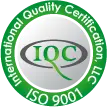In today’s highly competitive business environment, organizations must prioritize quality to gain a competitive edge. ISO 9001 is an internationally recognized standard for quality management systems that can help organizations meet this objective pretty easily. In this blog, we will explore the benefits of ISO 9001 certification and how it can improve an organization’s overall performance.
What is ISO 9001 Certification?
ISO 9001 is a standard for quality management systems that outlines a set of requirements for organizations to follow. The certification process involves a third-party certification body conducting an audit to verify that the organization’s quality management system meets the requirements of the standard. Once the organization meets the standard’s requirements, it receives ISO 9001 certification.
Below are some of the primary benefits of ISO 9001 certification for businesses.
Improved Customer Satisfaction
One of the primary benefits of ISO 9001 certification is a significant improvement in customer satisfaction. The standard requires organizations to focus on meeting customer needs and expectations by providing top-notch products and services. By implementing and adhering to ISO 9001, organizations can identify areas for improvement and implement processes to address customer complaints effectively. This focus on customer satisfaction can increase customer loyalty and drive sales.
Enhanced Process Efficiency
ISO 9001 certification requires organizations to establish and retain documented procedures for all key processes. This documentation ensures that processes are upheld to a standard and are repeatable and efficient. By streamlining processes, organizations can reduce waste and improve productivity. This increased efficiency can lead to cost savings and an upper hand in the marketplace.

Increased Employee Engagement
ISO 9001 certification requires organizations to define job responsibilities, provide training, and establish communication channels. By doing so, employees can better understand their roles and responsibilities, increasing engagement and job satisfaction. This engagement can lead to a more positive work environment, reduce employee turnover rate, and create a spike in productivity.
Improved Supplier Relationships
ISO 9001 certification requires organizations to establish and maintain a good relationship with their suppliers. By doing so, organizations can ensure that they receive high-quality products without being overcharged for the services that meet their needs. This collaboration can lead to a better understanding of the organization’s needs and increased trust between the organization and its suppliers.
Better Decision-Making
ISO 9001 requires organizations to establish processes for collecting and analyzing data to make informed, data-driven decisions. By collecting and analyzing data, organizations can identify the latest trends in addition to areas for improvement. This data-driven approach to decision-making can result in better business decisions and a more competitive position in the marketplace.

Competitive Advantage
ISO 9001 certification is an internationally recognized standard for quality management systems. By achieving this certification, organizations can set themselves apart from their competitors, demonstrating their unwavering commitment to quality and customer satisfaction. This competitive advantage is likely to lead to increased sales and revenue over time.
Improved Risk Management
ISO 9001 certification requires organizations to detect and manage risks that may impact the quality of their products or services. By doing so, organizations can reduce the likelihood of quality issues in the future and ensure that their products and services meet customers’ needs and expectations. This focus on risk management can also result in reduced costs associated with quality control and a better position in the marketplace.

How to Achieve ISO 9001 Certification
Achieving ISO 9001 certification requires a significant commitment of time and resources. The following are the key steps involved in the certification process:
· Establish a Quality Management System
The first step in achieving ISO 9001 certification is to establish a quality management system that meets the requirements of the standard. This involves documenting all key processes, procedures, and policies. Next, you must read and understand the requirements of the ISO 9001 standard to determine how it applies to your organization.
· Implement the Quality Management System
Once the quality management system is established, it must be implemented throughout the organization. This involves training employees on the system and ensuring that all processes are followed.
Evaluate your current quality management system against the requirements of the standard to identify gaps and areas for improvement.
· Conduct an Internal Audit
Before applying for certification, organizations must conduct internal audits to ensure that the QMS is being followed and is effective in meeting the requirements of the standard. Take corrective action to address any non-conformities identified during internal audits.

· Certification Audit
Select an accredited certification body to perform an audit of your QMS to determine if it meets the requirements of the ISO 9001 standard. If the certification audit is successful, you will receive ISO 9001 certification. Note that the certification process can take several months or longer, depending on the size and complexity of your organization. It may also involve significant resources and financial investment on your part.
· Maintain the QMS:
Continuously monitor and improve the QMS to ensure it remains effective in meeting the requirements of the standard. Regular internal audits and management reviews can help identify areas for improvement and ensure that the QMS remains effective.
All in all, achieving ISO 9001 certification requires understanding the requirements of the standard, conducting a gap analysis, developing an implementation plan, maintaining the QMS, etc. By achieving ISO 9001 certification, organizations can demonstrate their commitment to delivering quality products and services to their customers and gain a competitive advantage in the global market.
Now that you know the benefits of ISO 9001 certification, get in touch with the experts at International Quality Certification to get a certificate for your business. We not only provide ISO 9001 Registration Service, but also ISO 14001 environmental management, ISO 13485 certification, and ISO 45001 certification. To learn more about us, tap here.








